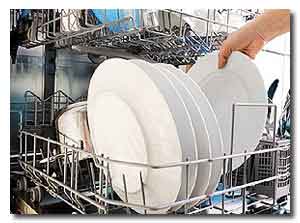|
Bacteria and fungi colonize the rubber seals of
dishwashers in biofilms—which are thin, slimy,
hard-to-eradicate films of these microbes that
adhere to surfaces.

Limiting factors, such as high temperatures, high
and low pH, high NaCl concentrations, presence of
detergents and shear force from water during washing
cycles define the microbial survival in this extreme
system.
Investigators have now shown that the diversity of
species in the biofilms correlates most strongly
with the age of the dishwasher, its frequency of
use, and the hardness of the tap water.
The types of bacteria most commonly found in the
samples were groups that include opportunistic
pathogens, notably Pseudomonas, Escherichia, and
Acinetobacter.
The most prevalent fungal groups, Candida,
Cruyptococcus, and Rhodotorula, are also known for
opportunistic pathogenicity, said coauthor Nina
Gunde-Cimerman, PhD, professor of Microbiology and
Mycology, University of Ljubljana, Slovenia.
The investigators obtained the bacteria by swab
sampling rubber seals on 24 household dishwashers,
followed by extracting the environmental DNA from
each.
Next generation sequencing was then used to
determine the species present in the biofilms.
The investigators also used a molecular tool called
“network interaction” to determine positive and
negative correlations among different
microorganisms.
“Positively correlated microorganisms contribute to
the development of the biofilms on the rubber
seals,” said Dr. Gunde-Cimerman.
The investigators used “predictive modeling” to
determine which microbes are the early colonizers of
the biofilms on the seals.
The investigators also performed statistical tests
on the information they obtained from the
householders on age of the dishwashers, hardness of
the tap water, and the condition of the seals, as
well as the microbial diversity in each dishwasher,
to determine the relative contributions of each
factor to the colonization process.
The genesis of the study was a moment of insight in
the latter 2000s.
For nearly two decades, Dr. Gunde-Cimerman had
studied fungi living in extreme environments.
Dishwashers, she realized, are artificial extreme
environments. She took a swab sample.
“The analysis in the lab revealed that my dishwasher
was full of the black yeast, Exophiala dermatitidis,”
she said, noting that it was known almost
exclusively from patients.
“When I asked my coworkers to sample their
dishwashers, we confirmed my results,” said Dr.
Gunde-Cimerman.
The study expanded to Slovenian students and later
to collaborators around the world, and in almost all
cases, the original finding was confirmed,” she
said.
That research was published in 2011. “The finding
was surprising, particularly in light of the extreme
conditions within the dishwasher, and the
consistency of the results,” she said.
“We now know that black yeasts on dishwashers’
rubber seals are a global phenomenon which might be
connected to increased incidence of mycoses in
immunocompromised people who spend a lot of time
indoors,” said Dr. Gunde-Cimerman.
The new research extends the work to bacteria.
The research is published January 12th in Applied
and Environmental Microbiology, a journal of the
American Society for Microbiology.
For more information
Applied and Environmental Microbiology
Microbiome in Dishwashers: Analysis of the microbial
diversity and putative opportunistic
pathogens in dishwasher biofilm communities
Link...
American Society For Microbiology
Link...
MDN |